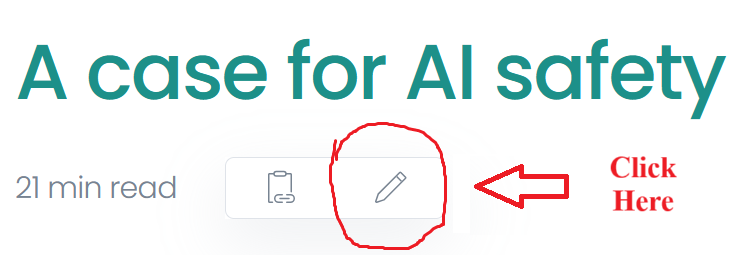TL;DR: The AISafety.info team wrote two intros to AI safety for busy laypeople: a short version and a longer version. We expect them to get a few thousand to tens of thousands of views. We'd really appreciate your critiques.
AISafety.info has two new intros: a short version and a longer version. They're intended for a reasonably smart member of the general public.
Our intros are meant to be:
- Aimed at a general audience.
- A frank presentation of our beliefs.
- Concise.
- Non-combative.
We want these intros to be a resource that you would be eager to share with friends, family, co-workers, etc. So, please give us some feedback! Even a 10 word comment would help. E.g. "Seems OK, but talking about AI doom to family is weird." Or "The section on instrumental convergence doesn't add much; consider shortening it." Even if you only read a tiny part of our intro, we still want your feedback! Even if it is to say why you think this project is even worth doing.
We're keen to learn what improvements to these articles would make them most useful to you as a shareable resource. (Of course, we'd also appreciate you catching any errors.) We list some of the feedback we're most interested in later on. Only then can we make the most of our upcoming opportunity to spread good models of AI safety to as many people as possible. Rob Miles is making an accompanying video which will link to our articles. We expect that to result in a big influx of viewers, who will share our articles if they find them useful.
The articles are listed below, with summaries. The first four from the long version are imported to LW as part of a sequence. (We'll eventually import the rest, but are avoiding spamming the front page.) You can give feedback 1) on this post (best for us), 2) by clicking on the links below and then clicking on the little pencil icon below the title, or 3) by commenting under the LW posts when they're published.

The Articles:
Short form:
A self-contained introduction that aims to draw people in with more of a narrative. It's a 16-minute read. We want this to be the one article someone can read about AI x-risks if they don't have time for anything else, and still get a decent picture of what it's about.
Summary: Companies are racing to build smarter-than-human AI. Experts think they may succeed in the next decade. But rather than building AI, they’re growing it — and nobody knows how the resulting systems work. Experts argue over whether we’ll lose control of them, and whether this will lead to everyone's demise. And although some decision-makers are talking about extinction risk, humanity does not have a plan.
Feedback we'd find most helpful: Object level feedback. Is the first paragraph engaging? Is the article engaging? Is it the right length? Does it place a high cognitive load on readers? Have we conveyed the risks you're worried about? Do we foreshadow content properly? Did we convey that there are deep models implying AI x-risks? Should we have more/fewer links? More/fewer footnotes? If you share the article with friends or family, what did they say about it?
Feedback on any part of this article would be helpful.
Long form:
A more detailed introduction providing a high-level overview of the arguments, which is meant to lead into the rest of the site. It has 4 subsections, with 14 articles in total. Each article should take 3–5 minutes to read.
We want this to be a set of articles that someone who's interested in the ideas around AI safety could read as their first introduction. We also think each article can serve as a stand-alone primer on its subtopic, which can be linked to without the context of the whole sequence.
Summary:
- AI systems far smarter than us may be created soon. AI is advancing fast, and this progress may result in human-level AI — but human-level is not the limit, and shortly after, we may see superintelligent AI.
- These systems may end up opposed to us. AI systems may pursue their own goals, those goals may not match ours, and that may bring us into conflict.
- Consequences could be major, including human extinction. AI may defeat us and take over, which would be ruinous. But there are other implications, including great benefits if AI is developed safely.
- We need to get our act together. Experts are worried, but humanity doesn’t have a real plan, and you may be able to help.
Feedback we'd find most helpful: Object level feedback. What's worth including or cutting? What's worth emphasizing or deemphasizing? Where should we change the tone? Where is it confusing or boring or illogical or factually wrong? How can it be made more engaging without compromising on concision and correctness? Where could the organization be (clearly) improved?
Feedback on any these articles, or any part, would be helpful.